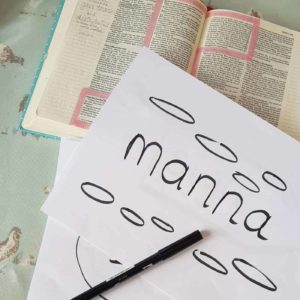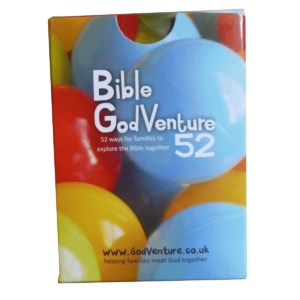
Make picture/word signs of keywords and challenge everyone to hold them up as they hear each word in the passage.
This activity works well with non-narrative passages, such as John 6 which is where Jesus says: I am the bread of life. It’s a good way to help people pay attention to the words, and then to explore what is said about each word.
We did this with 8 picture signs, with the word written in large letters on an A4 sheet with a simple picture around it to remind my emerging readers what the word is. I chose the words, but with older children, teens or adults I could have read the passage once and asked them which words jumped out to them, which were the key concepts in the passage.
The words I chose from John 6:25-59 were:
- sign
- manna
- bread
- life
- eternal
- believe
- I am
- heaven
The pictures I drew were very basic, a spiral for ‘eternal’, a blobbing looking loaf for ‘bread’, a speech bubble for ‘I am’, lines coming out from the word ‘life’ as if it were the sun, a sign post around the word ‘sign’, oval discs for ‘manna’ a cloud around the word ‘believe’ and an outline of a castle on a cloud (??!) for heaven. Not sure about that last one, but they knew what it meant!
If I wanted two more, I’d’ve gone for ‘raise up’ and ‘come down’. (These also lend themselves nicely to being actions. Or in a group, you could hand out arrows and have people point their arrows up or down.)
Then I gave my two 4 signs each and slowly read the passage, letting them hold up their signs at the right point.
I found it interesting thinking of which words to focus on, and then seeing the links between them develop. I’m keen to make a kind of diagram linking the words together to further explore this passage. We could do this using the picture/word signs we’ve made and link them with words or symbols which reflect what is said about each of the words in the passage. This passage lends itself well to exploring the Easter story and the reason Jesus died. The actual events in the death and resurrection, although important to read and meditate on, often don’t give us as much of the meaning and reason behind Jesus’ death and resurrection. Exploring this passage in the weeks running up to Easter allows us to think about why Jesus died and what it means for us before we get into the details of the Easter story.
You could also choose the words and allocate one per person and have them stand up or clap or run around the room and back to their place when they hear their word.
In a service, you could have people stand in the front and hold the signs up as the passage is read.
There are 52 creative ideas for exploring the Bible as a family in Bible GodVenture52

